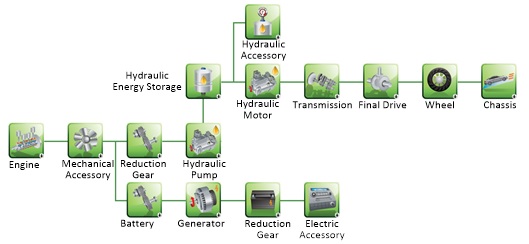For more than 20 years, the U.S. Department of Energy’s (DOE) Argonne National Laboratory has developed system simulation tools to evaluate the impact of advanced vehicle technologies on energy consumption and cost. While developers of the latest tool, Autonomie, initially focused on light-duty vehicles, expanding the capabilities supporting medium- and heavy-duty vehicles was the next logical step.
Results of that effort were reflected in a recent Argonne report, www.autonomie.net/publications/fuel_economy_report.html, which quantified the impact on energy and cost of several advanced vehicle technologies, including electrification across multiple medium- and heavy-duty vehicles. Still, interesting questions remained about off-road applications: What is the potential electrification impact on wheel loaders and excavators? What part of the powertrain and/or vehicle function (e.g., bucket motion, cabin rotation) should be electrified, if any? What is the potential for accessory load electrification? What duty cycles should be considered?
“Our extensive expertise in vehicle system simulation and control combined with the off-road expertise of our partners at University of Helsinki allowed us to quickly develop new models,” said Vincent Freyermuth. “Autonomie’s unique ability to quickly evaluate hundreds or thousands of vehicle designs is critical to manage the diversity of off-road applications.”
“Off-road vehicles provide a set of unique challenges and opportunities related to vehicle electrification,” said Vincent Freyermuth, Vehicle and Mobility Systems Engineer in the Energy Systems division at Argonne. “The trade-offs between the cost and energy benefits of advanced vehicle technologies in off-road vehicles are much more complex than those in on-road vehicles, due to the diversity of applications, duty cycles and vehicle functions.”
A recent workshop organized by the DOE Vehicle Technologies Office (VTO), which included manufacturers, suppliers and research organizations, highlighted the need for new system simulation tools to quickly and accurately identify the impact of new technologies. While developers ultimately seek to quantify any technology across all applications, the new off-road project focuses on assessing the benefits of VTO research and development activities, including new batteries, electric machines and engines.
“Gathering requirements from off-road manufacturers and suppliers was essential to the project,” said Aymeric Rousseau, Vehicle and Mobility Systems Manager in the Energy Systems division. “From selecting applications of interest to defining scenarios and implementing them in Autonomie, close collaboration is essential to put the new capabilities in the hands of users.”
To tackle the unique challenges associated with off-road modeling, Argonne has partnered with the University of Helsinki to use existing component models (e.g., engine, transmission) and controls developed for on-road applications to expand Autonomie capabilities to include dedicated off-road models (e.g., hydraulic pumps).
“Our extensive expertise in vehicle system simulation and control, combined with the off-road expertise of our partners at University of Helsinki allowed us to quickly develop new models,” Freyermuth said. “Autonomie’s unique ability to quickly evaluate hundreds or thousands of vehicle designs is critical to manage the diversity of off-road applications.”
Argonne and the University of Helsinki have been working closely with major industrial partners to ensure that the new Autonomie capabilities, which will be deployed to existing and future users, support their needs. “Autonomie’s new modeling capabilities will accelerate the development and deployment of advanced vehicle technologies for off-road applications,” said Rousseau.
Autonomie has been licensed to more than 275 organizations worldwide.
